This article is part of our Bilingual Blog series, where we share useful information and tips about non-language related aspects of Italian culture such as food, music, travel and more. These articles have been written in Italian and English to give our readers the opportunity to improve their reading skills whilst learning something new about Italy.
From elegant panna cotta to trays brimming with pasticcini, here are the best Italian desserts you should try on your next trip.
So, you’ve got all the top pasta dishes to try and the best pizzas not to miss on your trip to Italy, but how are you going to satisfy your sweet tooth? Worry not – Italy’s food highlights extend to its dessert choices, with sugary temptations everywhere.
While every region has its own sweet specialties, some have become authentic Italian icons. With that said, here are the 10 most famous Italian desserts you won’t want to miss!
Dall’elegante panna cotta ai vassoi traboccanti di pasticcini, ecco i migliori dolci italiani da provare durante il tuo prossimo viaggio.
Hai preso nota di tutti i migliori piatti di pasta da provare e le pizze da non perdere per il tuo viaggio in Italia, e il dessert? Non preoccuparti: le prelibatezze culinarie dell’Italia comprendono anche tante specialità dolciarie, con golose tentazioni ovunque.
Ogni regione ha i suoi dolci tipici, ma ce ne sono alcuni che sono diventati vere e proprie icone nazionali. Ecco allora i 10 dolci più famosi d’Italia da non perdere!

Gelato, the classic crowd-pleaser
Gelato, il classico che piace a tutti
Nothing screams Italy more than a cone of gelato! This delicious frozen treat is richer than ice-cream, containing more milk and fewer (or no) eggs, and is a year-round indulgence. Its history goes a long way back and takes us to the Renaissance when alchemist Cosimo Ruggieri created the very first gelato flavour – the fior di latte – at the Medici court in Florence. Fast-forward a few centuries, and visiting Italy isn’t complete without gelato. Besides, there are thousands of flavours to choose from, from classics like cioccolato and pistacchio to elaborate variations like crunchy cremino or mascarpone and nuts.
Tip: just outside Bologna, the Gelato University offers degrees in gelato making.
Non c’è niente di più italiano di un cono di gelato! Questo buonissimo dolce freddo è più ricco rispetto all’ice cream americano, contiene più latte e meno (o nessuna) uova, ed è una delizia da gustare tutto l’anno. La sua storia va molto indietro nel tempo e ci porta nel Rinascimento, quando l’alchimista Cosimo Ruggieri creò il primo gusto di gelato – il fior di latte – alla corte dei Medici a Firenze. Da allora è diventato un dolce iconico, tant’è che oggigiorno non si può dire di aver visitato l’Italia senza aver assaggiato il gelato. Inoltre, ci sono migliaia di gusti tra cui scegliere, dai classici come cioccolato e pistacchio a varianti elaborate come il cremino croccante o il mascarpone e noci.
Consiglio: appena fuori Bologna, l’Università del Gelato offre corsi di specializzazione per aspiranti gelatai.

Tartufo, a chocolatey frozen dessert
Tartufo, un dolce cioccolatoso a base di gelato
A true Italian specialty from the region of Calabria, the tartufo (truffle) is a chocolate-covered sphere filled with two gelato flavours – chocolate and hazelnut – plus a melting chocolate center. A gelato maker from Pizzo came up with the idea while preparing desserts for a wedding: with no cups left to serve his gelato, he started to shape it into rough balls and freeze them. It was the 1950s and some years later, tartufo became the first gelato with the P.G.I. designation. The same dessert can also be found in flavours like white chocolate, lemon, and pistachio.
Tip: one of the best places to try tartufo is Bar Gelateria Ercole in Pizzo’s central square.
Il tartufo è una specialità italiana d origine calabrese. Si tratta di una sfera di cioccolato ripiena di gelato – cioccolato e nocciola – e con un cuore di cioccolato fuso. Fu un gelataio di Pizzo ad inventare questo dolce negli anni ’50 mentre era alle prese con un banchetto nuziale: rimasto senza coppette per servire il gelato, pensò bene di creare delle palline e congelarle. Qualche anno più tardi, il tartufo sarebbe diventato il primo gelato a ricevere l’indicazione IGP. Oltre alla versione classica, è possibile trovare il tartufo in gusti diversi come cioccolato bianco, limone e pistacchio.
Consiglio: uno dei posti migliori per assaggiare il tartufo è il Bar Gelateria Ercole nella piazza centrale di Pizzo.
Cannoli, an iconic Sicilian confection
Cannoli, un iconico prodotto siciliano
Cannoli are a staple Italian dessert from Sicily. They are crunchy cylindrical shells filled with fresh ricotta and sprinkled with candied fruit, chocolate chips or chopped pistachios at both ends. Yum! Born during the Arabic domination of the island, they aren’t really considered a dessert but more like the perfect little treat for any occasion and at any time of the day. They come in a variety of sizes and the best ones are those filled upon order, so the shells don’t get soggy. Needless to say, they are a must when you visit the region.
Tip: the cannoli made in the Sicilian town of Piana degli Albanesi are considered the best in the world.
I cannoli sono un pilastro della pasticceria siciliana. Si tratta di croccanti cialde di forma cilindrica ripiene di ricotta fresca e cosparse di frutta candita, gocce di cioccolato o pistacchi tritati alle estremità. Una bontà! Nati durante la dominazione araba dell’isola, non sono proprio considerati un dessert ma più che altro un piccolo snack perfetto per ogni occasione e per qualsiasi momento della giornata. Ne esistono di varie dimensioni e i migliori sono quelli riempiti al momento, così la cialda non diventa molle. Inutile dire che sono un must quando si visita la regione.
Consiglio: i cannoli prodotti di Piana degli Albanesi sono considerati i migliori al mondo.
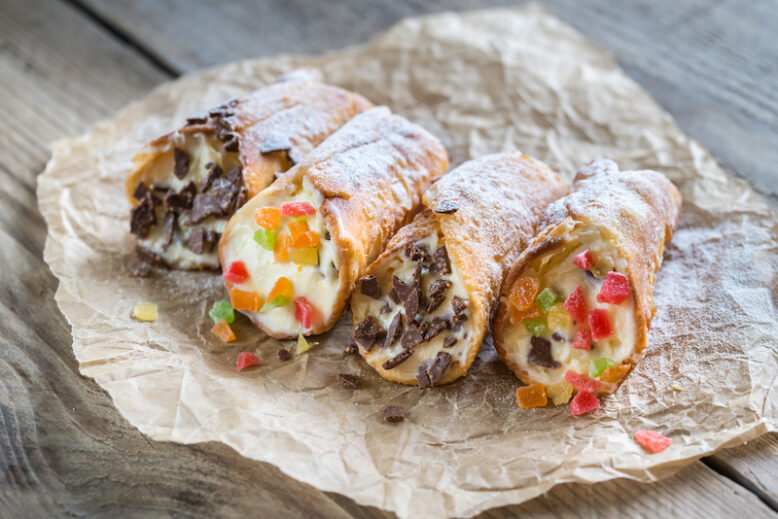
Panna cotta, a delicate sweet treat
Panna cotta, una delicata dolcezza
It is often said that the best things are the simplest ones and that’s the case with panna cotta. Literally meaning “cooked cream”, this famous Italian dessert consists of sweetened fresh cream that’s thickened with gelatin and served chilled with fresh fruit or various sweet sauces. Its delicate taste and delicious creaminess make it perfect to cap off an Italian meal. The history of panna cotta goes a long way back, though it appeared in Italian cookbooks only in the 1960s when a Michelin-starred chef from Piedmont first introduced it on his menu and put the recipe in writing.
Tip: panna cotta is an easy dessert to make at home and will impress your guests at a dinner party, just follow one of the many recipes you can find online.
Spesso di dice che le cose migliori sono le più semplici ed è proprio il caso della panna cotta. Questo famoso dolce italiano è a base di panna fresca zuccherata che viene addensata con gelatina e servita fredda con frutta fresca o varie salse. Il suo gusto delicato e la sua deliziosa cremosità rendono la panna cotta il dolce perfetto per concludere il pasto. Pur avendo una storia antica, la panna cotta fece la sua comparse nei libri di cucina solo a partire dagli anni ’60, quando uno chef piemontese stellato la inserì per la prima volta in menù, mettendo nero su bianco la ricetta.
Consiglio: la panna cotta è un dolce facile da preparare in casa e stupirà i vostri ospiti, basta seguire una delle tante ricette che trovate online.
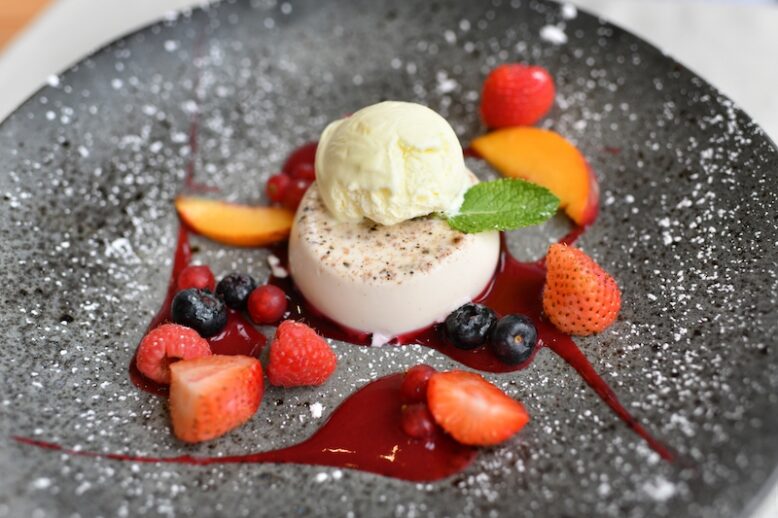
Panettone, Italy’s most famous Christmas dessert
Panettone, il dolce natalizio più famoso d’Italia
Around Christmas time, all the pastry shops and supermarkets in Italy fill up with panettone, a dome-shaped cake with candied fruit and juicy sultanas. History tells us that this delicacy was invented in Milan at the court of Ludovico il Moro in the 15th century to replace a burned cake during the preparation of Christmas dinner. Thank goodness for that mistake! Many Italians also eat panettone a few weeks before and after Christmas, with coffee at breakfast and a good glass of sweet wine at the end of a meal.
Tip: most panettone is made industrially these days, but if you’re in Milan, try Pasticceria Marchesi or Pasticceria Angelo Polenghi for artisanal ones.
Durante il periodo natalizio, tutte le pasticcerie e i supermercati d’Italia si riempiono di panettoni, i dolci a forma di cupola con frutta candita e succosa uva sultanina. La storia racconta che questa prelibatezza fu inventata nel XV secolo alla corte di Ludovico il Moro a Milano per sostituire una torta bruciata durante la preparazione del pranzo di Natale. Che fortuna quell’errore! Molti italiani mangiano il panettone anche qualche settimana prima e dopo il Natale, sia a colazione con il caffè che a fine pasto con un buon bicchiere di vino dolce.
Consiglio: oggigiorno la maggior parte dei panettoni è di produzione industriale, ma se sei a Milano, prova quello artigianale della Pasticceria Marchesi o della Pasticceria Angelo Polenghi.
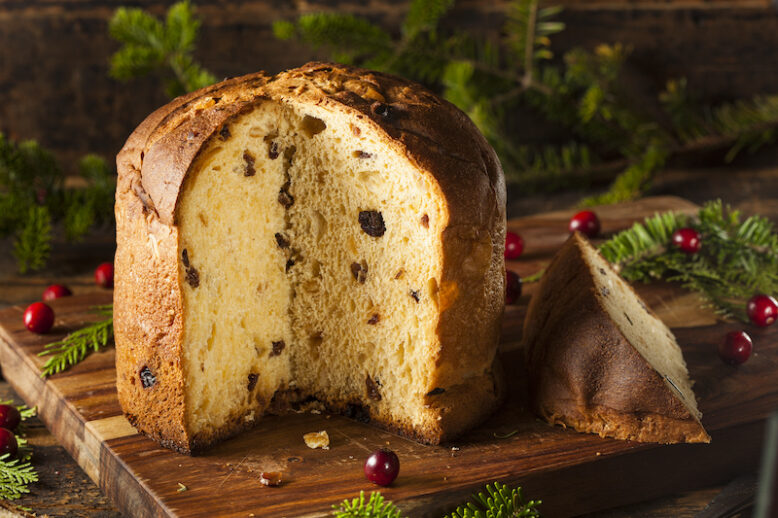
Zuppa Inglese, the layered dessert with an odd name
Zuppa Inglese, il dolce a strati dal nome curioso
Zuppa inglese literally means “English soup”, but it’s neither English nor a soup. In fact, this dessert is particularly popular in Central Italy, where three regions compete for its paternity – Marche, Tuscany, and Emilia Romagna. This Italian dessert, however, has quite a few similarities with the English trifle, with layers of sponge cake soaked in a sweet red liqueur called Alchermes, alternated with custard and chocolate cream. It’s usually served in transparent glasses to show off the colourful layers, while crunchy shaved almonds and cocoa powder top it off.
Tip: zuppa inglese is so popular it even has a gelato flavour!
A dispetto del nome, la zuppa inglese non è né una zuppa, né tantomeno inglese. Si tratta infatti di un dolce particolarmente diffuso nell’Italia centrale, dove tre regioni si contendono la paternità: Marche, Toscana ed Emilia Romagna. Questo dolce italiano, però, ha non poche somiglianze con il trifle inglese. È infatti composto da strati di Pan di Spagna imbevuto di un dolce liquore rosso chiamato Alchermes, alternati a crema pasticcera e al cioccolato. Di solito la zuppa inglese viene servita in bicchieri trasparenti per mettere in risalto gli strati colorati, e decorata con cacao o croccanti scaglie di mandorle.
Consiglio: la zuppa inglese è un dolce così famoso da diventare anche un gusto di gelato!

Pasticcini, the quintessential Italian dessert
Pasticcini, il dolce italiano per eccellenza
There’s nothing more Italian than sharing a tray of assorted pasticcini at the end of the family Sunday lunch or to celebrate a special occasion. These bite-sized pastries come in all shapes and flavours, plain or beautifully decorated. There may not be much to their story, but they hold a special place at Italian tables, where it’s always fun to watch kids (and adults) fight over the best ones from the tray before they’re gone. The most popular pasticcini include cannoncini (cream horns), bignè (cream puffs), and mini fruit tarts. They are great with coffee or a chilled glass of spumante.
Tip: Iginio Massari is one of the greatest Italian pastry chefs and you can try his pasticcini in one of his shops across Italy.
Simbolo del pranzo domenicale in famiglia e delle occasioni speciali, il vassoio di pasticcini assortiti è senza dubbio emblema di italianità. Queste piccole delizie sono disponibili in varie forme e gusti, semplici o decorati. Pur non avendo una storia particolarmente intrigante, i pasticcini occupano un posto speciale sulle tavole degli italiani, dove è sempre divertente guardare i bambini (e gli adulti) fare a gara per accaparrarsi i pezzi preferiti dal vassoio prima che finiscano. I pasticcini più famosi sono i cannoncini, i bignè alla crema e le crostatine alla frutta. Sono ottimi sia con il caffè che con un bicchiere di spumante fresco.
Consiglio: Iginio Massari è uno dei più grandi esponenti della pasticceria italiana e puoi provare le sue creazioni in uno dei suoi tanti negozi.
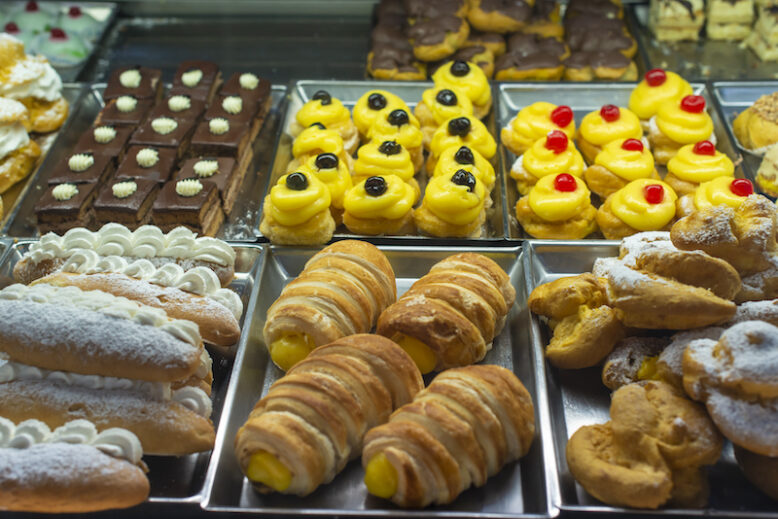
Biscotti, the perfect sweet snack
Biscotti, il perfetto snack dolce
For a crunchy treat, there are all kinds of biscotti in Italy. Available in countless flavours and textures, biscotti are a key component of an Italian breakfast and a sweet treat to accompany a cup of coffee or a glass of sweet wine. Classics include cantucci (the famous crunchy almond cookies from Tuscany), canestrelli (flower-shaped crumbly cookies dusted with powdered sugar), and baci di dama (hazelnut butter cookies with a creamy chocolate filling).
Tip: if you are in Rome and want to stock up on artisanal Italian biscotti, visit Biscottificio Innocenti in the heart of Trastevere.
Per una coccola croccante, ci sono tantissimi tipi di biscotti in Italia. Disponibili in svariati gusti e consistenze, i biscotti sono un elemento fondamentale della colazione italiana, ma anche uno snack ideale per accompagnare una tazza di caffè o da inzuppare in un bicchiere di vino dolce. Tra i più diffusi ci sono i cantucci (i famosi biscotti croccanti toscani alle mandorle), i canestrelli (biscotti friabili a forma di fiore spolverati di zucchero a velo) e i baci di dama (biscotti con un impasto a base di burro e nocciole, con un ripieno di cremoso cioccolato).
Consiglio: se ti trovi a Roma e vuoi fare scorta di biscotti artigianali, visita il Biscottificio Innocenti nel cuore di Trastevere.
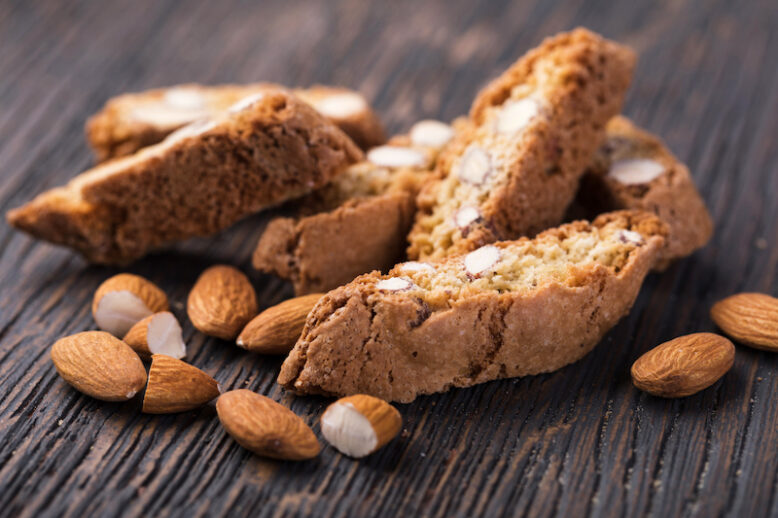
Babà, the king of Neapolitan confectionery
Babà, il re della pasticceria napoletana
Soft, juicy, and utterly delicious, babà is a spongy cake soaked in sweet rum syrup. It’s served plain or with some whipped cream and fresh fruit. This famous Italian dessert is so rooted in the Neapolitan culture that it’s even entered everyday language with the phrase “si nu’ babbà” (“you are a babbà”) to compliment someone kind and helpful. However, its origin has little to do with Campania’s capital. It was invented in the 17th century by a Polish king while exiled in the French region of Lorraine and came to Naples with the Bourbons, where it got its famous mushroom shape.
Tip: when in Naples, visit Scaturchio, a historic pastry shop that invented “Babà Vesuvio”, a big babà in the shape of the famous volcano.
Soffice, succoso e dannatamente buono, il babà è un dolce con una pasta spugnosa imbevuta di sciroppo al rum. Viene servito liscio o con frutta fresca e panna montata. Questo famoso dolce italiano è talmente radicato nella cultura partenopea da essere entrato addirittura nella lingua di tutti i giorni con l’espressione “si nu’ babbà” (sei un babbà) per indicare una persona dolce e gentile. Tuttavia, l’origine di questo dolce ha poco a che fare con il capoluogo campano. Il babà fu infatti inventato nel XVII secolo da un re polacco in esilio nella regione francese della Lorena e giunse a Napoli con i Borbone, dove assunse la famosa forma a fungo.
Consiglio: a Napoli, visita Scaturchio, la storica pasticceria che ha inventato il “Babà Vesuvio”, un grande babà a forma del famoso vulcano.

Tiramisu, the most famous Italian dessert
Tiramisù, il dolce più famoso d’Italia
Let’s finish with the best. Unless you’ve been living on another planet, you’ve undoubtedly heard of Italy’s sweet star, tiramisu. Made with layers of coffee-soaked ladyfingers and soft mascarpone cheese cream, all dusted with plenty of cocoa powder, this luscious Italian dessert is quite the indulgence. Its origin is uncertain, although it’s believed it was invented by a maitresse in Treviso in the 1800s in order to reinvigorate her clients. One bite, and you feel revitalised! While the classic is a firm favourite, there are many variations that are just as yummy, replacing the coffee with things like strawberries or pumpkin.
Tip: try this famous Italian dessert at Le Beccherie in Treviso, where the original tiramisu recipe is still served.
Chiudiamo con il pezzo forte. A meno che fino adesso tu non abbia vissuto su un altro pianeta, avrai sicuramente sentito parlare del dolce italiano per eccellenza, il tiramisù. Realizzato con strati di savoiardi imbevuti di caffè e morbida crema al mascarpone, il tutto spolverato con abbondante cacao in polvere, questo delizioso dolce italiano è una vera bontà. La sua origine è incerta, anche se si ritiene sia stata inventato da una maitresse di Treviso nel 1800 come energizzante per i suoi clienti. Un morso e ci si sente subito rinvigoriti! La versione classica rimane quella preferita, ma oggigiorno esistono molte varianti che sostituiscono il caffè con ingredienti quali le fragole o la zucca.
Consiglio: assaggia questo famoso dolce italiano a Le Beccherie, il ristorante di Treviso dove viene ancora servita la ricetta originale del tiramisù.

Valentina is a travel writer in love with her country. Having travelled widely around the globe, she realised there was more to explore closer to home and decided to put the passport aside for a while. You can follow her adventures around Italy on her blog myitaliandiaries.com.

Valentina Nicastro is a travel writer in love with her home country, Italy. Having travelled widely around the globe, she realised there was more to explore closer to home and decided to put the passport aside for a while. When she is not immersed in documenting Italy, you’ll find her donning her communication consultant hat, weaving words as a content writer and bridging linguistic divides as a translator.


